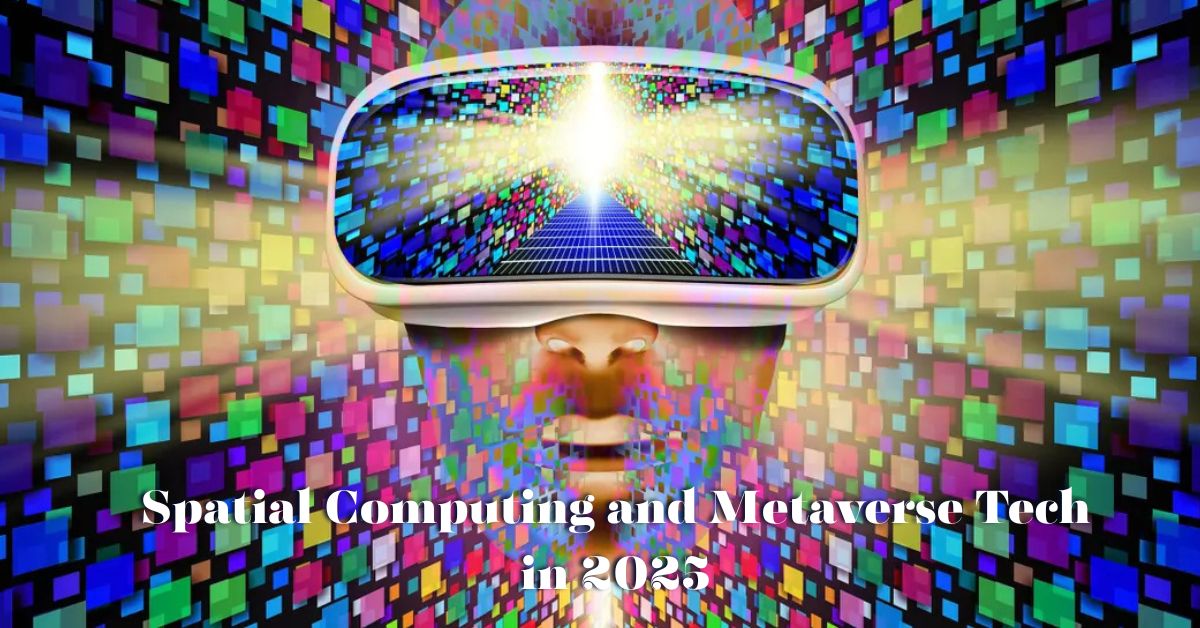Technology keeps changing at a speed we can hardly imagine. One of the biggest changes happening right now is the growth of spatial computing and metaverse tech in 2025. These two ideas are not just buzzwords anymore. They are already shaping how we interact with digital content and how we live our daily lives. In this article, we will look at what spatial computing is, what the metaverse means, and how both are becoming an important part of 2025.
What is Spatial Computing?
Spatial computing in 2025 is the bridge between the digital world and the physical world. Instead of only using screens, keyboards, or touch, spatial computing uses new ways of interaction such as 3D environments, gestures, voice commands, augmented reality (AR), and virtual reality (VR).
Think about wearing AR glasses that show directions on the street while you walk, or using a VR headset to join a meeting where everyone feels present in the same room. These are simple examples of spatial computing. The name “spatial” comes from its ability to understand the space around you and respond to it.
What is the Metaverse?
The metaverse in 2025 is like a 3D internet. It is a virtual world where people can meet, work, shop, and play inside immersive spaces. Instead of scrolling on a flat screen, you can move around in a virtual environment through your avatar.
In the metaverse, you can attend concerts, shop for clothes, decorate your digital home, or even join classes. By 2025, the metaverse is expanding beyond gaming. It is being used for remote work, education, training, shopping, and even healthcare.
Spatial Computing and Metaverse: How They Work Together
Spatial computing and metaverse technology are closely connected. The metaverse cannot exist without spatial computing because to create realistic digital worlds, you need AR, VR, AI, and 3D interaction.
For example, when you walk around a virtual shopping mall in the metaverse, spatial computing tracks your movements to make the experience real. When you join a virtual office meeting, spatial computing makes you feel as if you are sitting with your team in the same space. For gamers, it allows gestures to control characters naturally inside 3D games. In short, spatial computing is the engine, and the metaverse is the experience that comes from it.
Spatial Computing and Metaverse Tech in 2025
By 2025, these technologies are becoming part of normal life. They are not just experiments anymore. Here’s how spatial computing and metaverse tech in 2025 are being used today.
Remote work has become more interactive with virtual offices. Instead of flat video calls, teams can wear VR headsets and feel like they are sitting around one table. This makes online meetings more real.
Education is also changing. Schools are using VR classrooms where students can explore science, history, or even space in 3D. Companies are training workers using VR simulations, which makes learning safer and more effective.
Shopping is another area where the metaverse is growing. You can enter a virtual store, try clothes through AR, or see how furniture looks in your living room before buying it. Many fashion brands are already hosting virtual fashion shows inside the metaverse.
Gaming and entertainment remain the strongest area. In 2025, many games are now fully immersive, letting players step inside digital worlds. Concerts, movies, and sports are also moving into virtual spaces.
Healthcare is using AR and VR in amazing ways. Doctors can train using virtual surgeries, and patients can take part in therapy sessions inside safe digital environments.
Challenges of Spatial Computing and the Metaverse
Even though the future looks bright, there are still challenges. Devices like AR glasses and VR headsets are expensive for many people. Strong internet and advanced hardware are needed to enjoy smooth experiences. Privacy is another concern, as digital spaces collect large amounts of data. There is also the risk of overuse, where people spend too much time in virtual worlds instead of balancing with real life.
The Future of Spatial Computing and the Metaverse
Despite the challenges, the future of spatial computing and the metaverse in 2025 looks strong. Big companies like Meta, Apple, Microsoft, and Google are investing heavily in this space.
In the coming years, we may see AR glasses that are cheap enough to replace smartphones. Virtual offices may become as common as email or video calls. Shopping malls inside the metaverse could become normal, and schools might mix real and digital classrooms together. The line between digital life and physical life will keep getting thinner.
Final Thoughts
Spatial computing and metaverse tech in 2025 are changing the way we live, work, and connect with each other. They are making the digital world more real and interactive. From education and healthcare to gaming and shopping, the effects can already be seen everywhere.
As more people adopt these technologies, learning how to use them will be a big advantage. For businesses, creators, and even normal users, this is the right time to explore spatial computing and the metaverse.



1 thought on “Spatial Computing and Metaverse Tech in 2025”